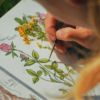Have you ever imagined a world or your surroundings in just solids? How plain and lifeless it would be! Patterns certainly play a crucial role. We see them exist in nature, from rainbows; water ripples to spider webs, honeycombs, and the markings on animal coats. When it comes to art, we have witnessed patterns that have been in use in ancient times. Remember the famous artist, William Morris, and his splendid prints for textiles and wallpaper? They create life to a piece of art, fabric, or to any of the materials that you use, which leads to the growth of the surface pattern design industry and the need for an artist or a designer who can create magical patterns to bring life to people’s souls.
What is Surface Pattern Design?
The term ‘Surface Pattern Design’ is fairly new, though this style of art exists for years, but not known or famous as Graphic Design or Photography. It is a skill or an artwork specifically created and applied as surface decorations to enhance the visual appearance or functionality of a product.
Where do we find Surface Pattern Design?
Look around. You will find it everywhere. From your bed covers and your towels, to the clothes you are wearing and sometimes on the walls to make it look fancy.
What does a Surface Pattern Designer do?
Textile designers, often called surface pattern designers, are designers who create artwork which is printed onto fabric for use in the apparel, fashion and home marketplace. In addition to creating original artwork, textile designers create patterns and repeats that give life, energy and movement to the surfaces. To be a successful Surface Pattern Developer, understanding trends, colour forecasting and having one’s own design personality is the entire key.
What are the career paths for a Surface Pattern Designer?
The answer to this lies in your goals and preferences as the options are myriad.
Freelance Designer: As the textile and surface pattern designer, one has the opportunity to work as a freelancer or a self-employed designer. Setting up your own business, finding clients, brands and serving to them directly.
Licensor: Licencing your pattern designs will mean selling your own designs to your suitable client yet retaining the copyright. This occupation merely works on a contract based that allows the client to use your designs with an agreed terms and conditions. Post the contract, your client cannot use it without your permission.
Designer/Maker: You might have a creative vision of wanting to bring your own designs to life in the form of a product. This will allow you to be the creator of the design as well as the product where your role will be from the initial concept building to the selling of that product in the market.
Full time Employee in a textile company or a brand: We have various fashion and lifestyle brands who hire in-house designers and manufacturers to create designs for them that will legally called under the specific brand/name of the company. This won’t be like 9 to 5 desk job, but a full time exposure with challenges and creativity.
Educator: If you become the master of this art, you also have the window open to teach and educate the prospective designers and students about surface pattern design, its roles and techniques in the industry.




